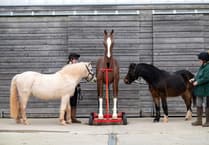A HISTORY of the town – not dry and dusty but very much alive – was presented by North Tawton Events Group in a pop-up museum over the weekend of November 19 and 20.
Members of the public not only viewed the collection of maps, photographs, posters, domestic records and transcribed tapes, but contributed additional items and added their own memories to the commentaries on photographs.
The exhibition spanned the last century, with the oldest poster – for horse racing in the town - dating back to 1861, and the oldest information coming from the Napoleonic era when prisoners of war were housed in the town.
A poster announced the town’s celebrations for the Coronation of King George V in 1911. These celebrations included “a dinner for males of 15 years of age”, each to take his own knife and fork, a tea for children, and “a tea for all females over 15 years of age”.
Additional panels detailed archeological finds from around 48 AD, when North Tawton was a Roman camp, possibly known as Nemetostatio.
The source of most of the 18th and 19th century material was an archive compiled by the late Dr Jean Shields and rediscovered in the eaves of a church that was being refurbished as a Community Centre. The exhibition took place in the building where the material was found.
The archive included hours of taped interviews with residents of the town, conducted in the 1990s with memories going back to the earliest years of the century and spanning both world wars. Snippets from the transcribed tapes were mounted and posted around the rooms of the community centre, allowing the voices from the past to be heard.
Visitors could also listen to a conversation with Jack Gregory who was born in 1924 and whose father founded the haulage company. And mention was also made of the BBC sitcom series “Jam and Jerusalem”, broadcast between 2006 and 2009, and shot largely in North Tawton.
But the highlight of the weekend was a magic lantern show which brought the pop-up museum to a close on the Sunday. There were two performances of the show where the audience saw slides that most likely had not been seen for 100 years. The Victorian magic lantern was found in a cupboard during the refurbishment of the centre. So far as is known, it belonged to a shoemaker called Samuel Taylor who lived in the town’s square. His grandson, who died in 2002, inherited the lantern which was found with slides and notes on the slides. It was made by a London firm, William Tyler, which was opposite Waterloo Station.
Operating the lantern was Dr Richard Crangle, a member of the Magic Lantern Society in Exeter. Dr Crangle said that they suspected the magic lantern had only ever made one journey – from Waterloo to North Tawton.
Story tellers Michael and Wendy Dacre provided an updated narrative to accompany the slides, and music was provided by Andy Marshall on guitar and Paul Cherrett playing the fiddle.
More than 150 people came through the doors during the hours that the pop-up museum was in place, and while there have been requests for further pop-up museums, there is also interest in establishing a permanent museum for the town, perhaps to be staffed by volunteers and accessed on an appointment basis.




